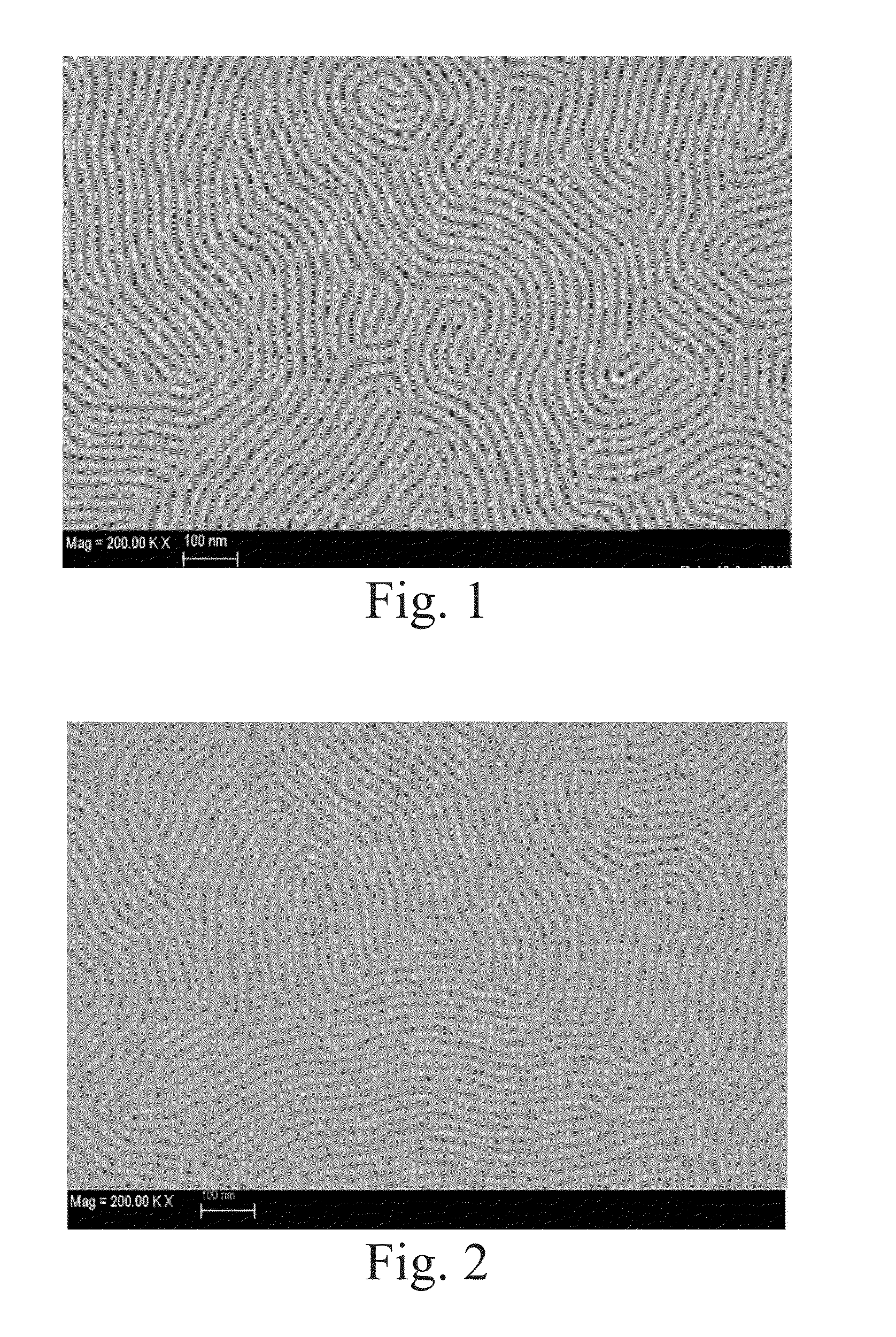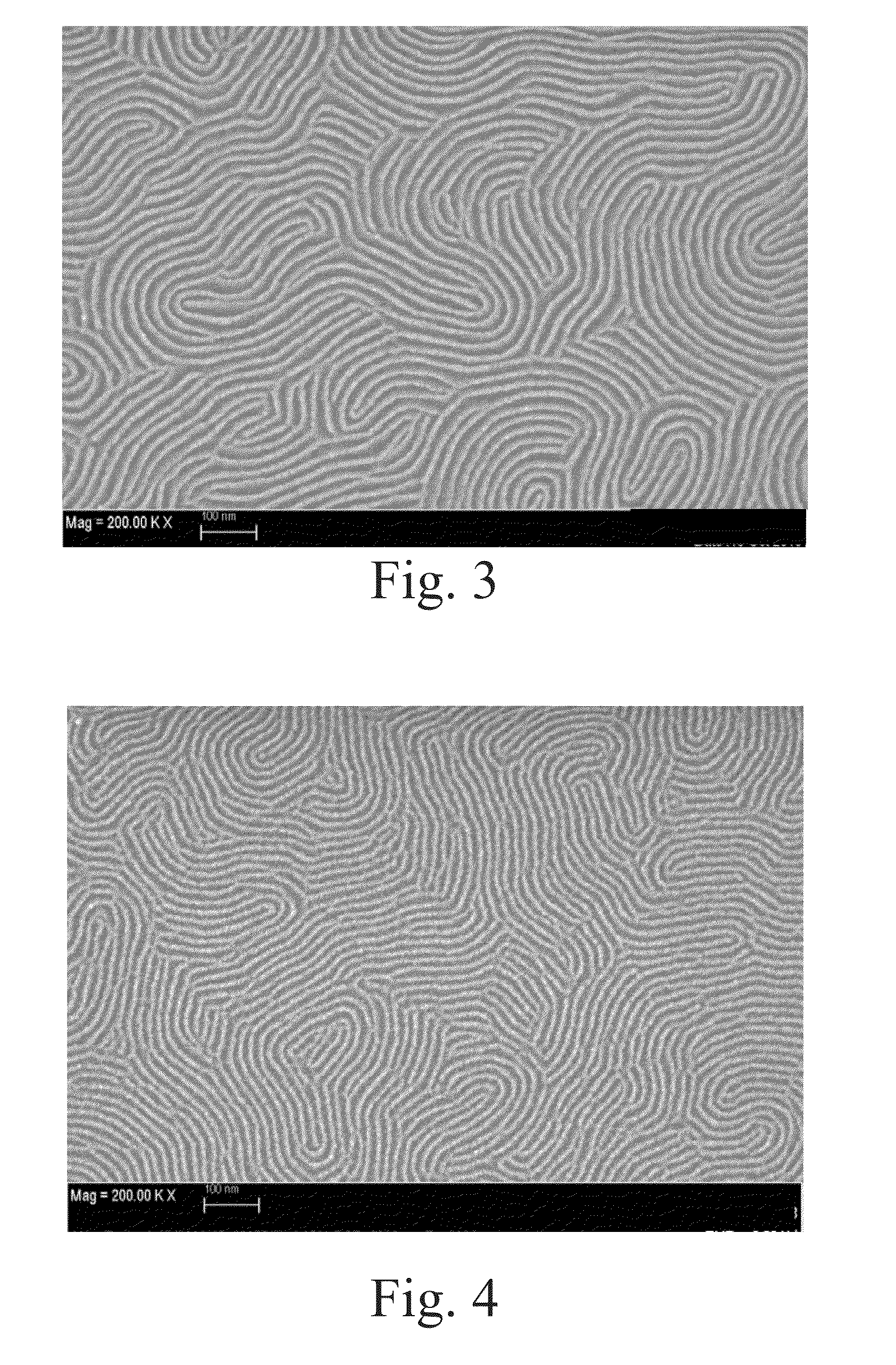High-chi block copolymers for directed self-assembly
a high-chi block and self-assembly technology, applied in the direction of synthetic resin layered products, microcapsules, inks, etc., can solve the problems of increasing manufacturing costs and complication, increasing manufacturing costs, and increasing the difficulty of directing and orientating high-chi block morphologies, etc., to achieve the effect of facilitating alignment and surface energy
- Summary
- Abstract
- Description
- Claims
- Application Information
AI Technical Summary
Benefits of technology
Problems solved by technology
Method used
Image
Examples
example 1
Synthesis of 70 / 10 / 20 P(S-FS-VBCB)-b-PMMA)
[0077]A mixed solution of 518 milligrams of 2-cyano-2-propyl dodecyl trithiocarbonate (Sigma-Aldrich, St. Louis, Mo.), 35.0 grams of methyl methacrylate (Sigma-Aldrich, St. Louis, Mo.), and 28 milliliters of toluene (Sigma-Aldrich, St. Louis, Mo.) was prepared in a round-bottom flask and stirred at room temperature for 15 minutes under nitrogen atmosphere. The prepared solution was transferred into a Schlenk reaction flask, and 24.6 milligrams of 2,2′-azobis(2-methylpropionitrile) (Sigma-Aldrich, St. Louis, Mo.) was added afterwards. The Schlenk reaction flask was de-gassed by three consecutive freeze-evacuate-thaw cycles and sealed in vacuum. The polymerization was carried out at 60° C. for 16 hours. A viscous reaction mixture was obtained and diluted with 50 milliliters of dichloromethane (Sigma-Aldrich, St. Louis, Mo.). The polymer product was precipitated in 1 liter of methanol (Sigma-Aldrich, St. Louis, Mo.) and collected by filtration....
example 2
Synthesis of 60 / 20 / 20 P(S-FS-VBCB)-b-PMMA)
[0079]A mixed solution of 518 milligrams of 2-cyano-2-propyl dodecyl trithiocarbonate (Sigma-Aldrich, St. Louis, Mo.), 35.0 grams of methyl methacrylate (Sigma-Aldrich, St. Louis, Mo.) and 28 milliliters of toluene (Sigma-Aldrich, St. Louis, Mo.) was prepared in a round-bottom flask and stirred at room temperature for 15 minutes under nitrogen atmosphere. The prepared solution was transferred into a Schlenk reaction flask, and 24.6 milligrams of 2,2′-azobis(2-methylpropionitrile) (Sigma-Aldrich, St. Louis, Mo.) was added afterwards. The Schlenk reaction flask was de-gassed by three consecutive freeze-evacuate-thaw cycles and sealed in vacuum. The polymerization was carried out at 60° C. for 16 hours. A viscous reaction mixture was obtained and diluted with 50 milliliters of dichloromethane (Sigma-Aldrich, St. Louis, Mo.). The polymer product was precipitated in 1 liter of methanol (Sigma-Aldrich, St. Louis, Mo.) and collected by filtration. ...
example 3
Synthesis of 40 / 20 / 40 P(S-FS-VBCB)-b-PMMA)
[0081]A mixed solution of 518 milligrams of 2-cyano-2-propyl dodecyl trithiocarbonate (Sigma-Aldrich, St. Louis, Mo.), 35.0 grams of methyl methacrylate (Sigma-Aldrich, St. Louis, Mo.), and 28 milliliters of toluene (Sigma-Aldrich, St. Louis, Mo.) was prepared in a round-bottom flask and stirred at room temperature for 15 minutes under nitrogen atmosphere. The prepared solution was transferred into a Schlenk reaction flask, and 24.6 milligrams of 2,2′-azobis(2-methylpropionitrile) (Sigma-Aldrich, St. Louis, Mo.) was added afterwards. The Schlenk reaction flask was de-gassed by three consecutive freeze-evacuate-thaw cycles and sealed in vacuum. The polymerization was carried out at 60° C. for 16 hours. A viscous reaction mixture was obtained and diluted with 50 milliliters of dichloromethane (Sigma-Aldrich, St. Louis, Mo.). The polymer product was precipitated in 1 liter of methanol (Sigma-Aldrich, St. Louis, Mo.) and collected by filtration....
PUM
| Property | Measurement | Unit |
|---|---|---|
| Size | aaaaa | aaaaa |
| Nanoscale particle size | aaaaa | aaaaa |
| Structure | aaaaa | aaaaa |
Abstract
Description
Claims
Application Information
 Login to View More
Login to View More - R&D
- Intellectual Property
- Life Sciences
- Materials
- Tech Scout
- Unparalleled Data Quality
- Higher Quality Content
- 60% Fewer Hallucinations
Browse by: Latest US Patents, China's latest patents, Technical Efficacy Thesaurus, Application Domain, Technology Topic, Popular Technical Reports.
© 2025 PatSnap. All rights reserved.Legal|Privacy policy|Modern Slavery Act Transparency Statement|Sitemap|About US| Contact US: help@patsnap.com



